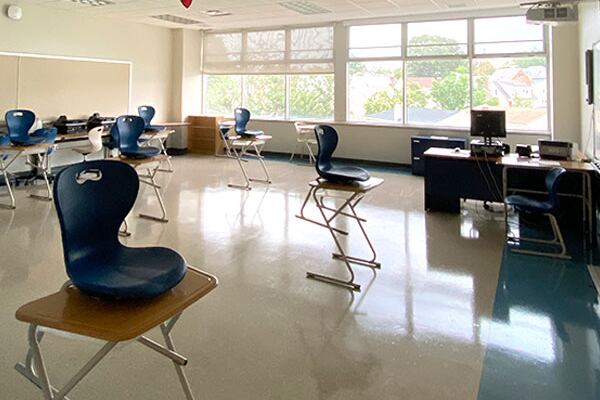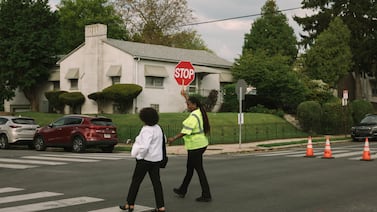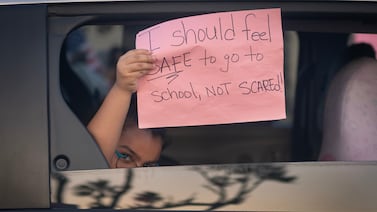Across New Jersey, calls are rising to delay in-person learning and districts are opting to start the school year fully remote. But in Newark, the state’s largest school system remains steadfast in its plan to reopen classrooms in just a few weeks.
Education union leaders and several state lawmakers have demanded that schools begin the year virtually due to the health risks posed by the coronavirus pandemic. And after Gov. Phil Murphy this week relaxed his requirement that every district offer some in-person learning, a growing number of school systems are planning to go all-remote. They include some of the state’s biggest districts, such as Camden, Elizabeth, Jersey City, and Paterson, as well as several in Essex County, including East Orange and Montclair.
The push for an all-online start of the school year has also found support in Newark, where the city’s largest charter school networks are opening virtually and Mayor Ras Baraka advised families against sending their children back to classrooms.
Yet Newark’s traditional school district is moving forward with its plan to offer daily in-person classes to families who want them when school starts Sept. 8. As required by the state, the district also gave families the option of all-remote learning, which they had through Friday to select.
“We are ready to provide you with an incredible experience regardless of what you choose,” Superintendent Roger León told parents during a recent online chat.
Newark’s commitment to in-person learning has been heartening to families who are desperate for their children to return to school. Many parents struggled to balance work and their children’s at-home learning during the months-long school closure this spring, and many students languished academically and emotionally.
“The kids need to be back in school,” said Natasha Arrington, who plans to send her children back in person to Harriet Tubman School next month.
Remote learning was tough for her two children, who had to share a single school-issued laptop this spring. Her daughter, a first-grader, got tired of staring at a screen and her son, who’s in sixth grade, grew despondent after spending months away from his friends. And Arrington, who does housekeeping at a local hospital, can’t afford to stay home this school year.
“Without this job, I have no income to take care of my children,” she said. “I don’t have any kind of rental assistance, so I have to go to work or I’ll be homeless with my kids.”
Other families also struggled with remote learning, and yet they still don’t feel safe sending their children back to school.
This spring, Yoly Vaz tried to help her three children with their assignments when she got home in the mornings from the overnight shift at the warehouse where she works. But her daughter’s preschool did not give her a device for virtual learning, and the laptop the school provided one of her sons was faulty and could not load the required learning apps, she said.
Even so, Vaz plans to keep her children home this fall. She doubts that students who return to classrooms will follow the district’s safety guidelines, such as mandatory face coverings and physical distancing, and she worries that the aging school buildings are not properly ventilated.
“I’d rather them miss the year than get sick and have some type of damage to their respiratory system,” she said.
The decision to keep children home is high-stakes. Unlike some districts, Newark will not let families switch during the year from all-remote to in-person.
“As of right now, whatever you pick will be what you actually will be doing until we get a green light that everyone is required to return back,” León told parents during an online chat. “So we need you to pick wisely.”
But making an informed decision has been difficult amid so much uncertainty, some parents and teachers said.
For instance, the district has said little about what remote learning will look like this fall, including whether all students will receive live instruction over video, which was not the case this spring. The district also has not said how many laptops it’s purchased; in June, officials said an additional 10,000 laptops were needed in order for every student to get one. Other districts, such as Paterson, have had difficulties obtaining the laptops they ordered.
It’s also not entirely clear what students’ daily schedules will be. While León has said students who choose in-person learning will come to school five days a week, individual schools have told families that the number of class days will depend on how many families choose in-person learning.
Meanwhile, some teachers say they’re received confusing or vague responses to their questions.
For instance, during an online question-and-answer session this week, León told teachers that custodians will thoroughly sanitize their rooms each day — but that teachers are also responsible for cleaning their own rooms. He said teachers might have to give in-person and online lessons simultaneously, but didn’t say for sure. And when asked about the limited air circulation in some schools, which many teachers worry could lead to airborne transmission of the virus, León said he’s “asking everyone to be flexible” and “very, very patient.”
Those responses did not sit well with some teachers.
“There’s still a lot of questions that have not been answered in a manner that make a lot of teachers feel safe,” said an educator in a North Ward school who asked to remain anonymous to avoid retaliation from the district.
Like many educators, she’s worried that the district’s new safety guidelines will not be properly implemented. And while she wants to be back in the classroom with her students, she requested to work remotely until she’s confident she can return to work safely.
“I don’t think teachers need to be the sacrificial lambs,” she said. “A lot of people are very nervous and they just feel like, ‘Why not hold off?’”






